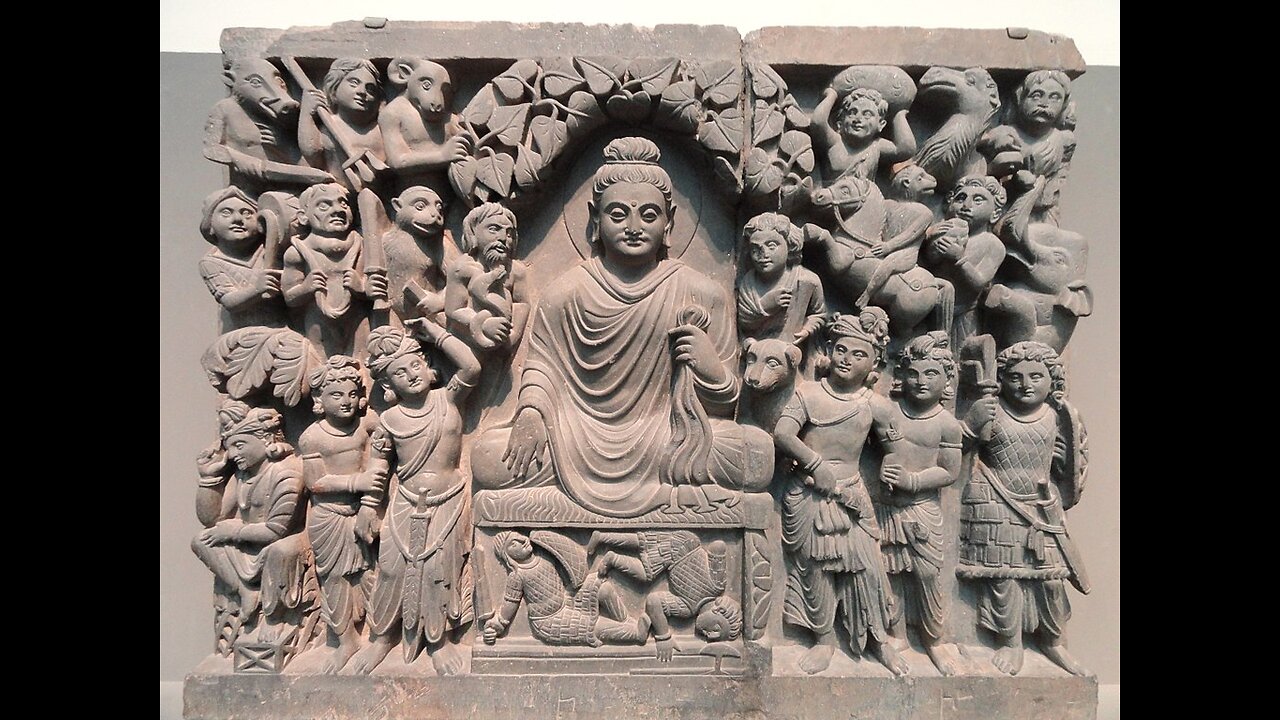Premium Only Content

CIA Archives: Buddhism (1958)
The dark side of history: https://thememoryhole.substack.com/
Buddhism (/ˈbʊdɪzəm/ BUUD-ih-zəm, US also /ˈbuːd-/ BOOD-),[1][2][3] also known as Buddha Dharma, and Dharmavinaya (transl. "doctrines and disciplines"), is an Indian religion or philosophical tradition based on teachings attributed to the Buddha.[4] It originated in the eastern Gangetic plain as a śramaṇa–movement in the 5th century BCE, and gradually spread throughout much of Asia via the Silk Road. It is the world's fourth-largest religion,[5][6] with over 520 million followers (Buddhists) who comprise seven percent of the global population.[7][8][9]
The Buddha's central teachings emphasize the aim of attaining liberation from dukkha (often translated as "suffering" or "unease"[note 1]), the source of which is said to be attachment or clinging.[14] He endorsed the Middle Way, a path of development that avoids both extreme asceticism and hedonism. A summary of this path is expressed in the Noble Eightfold Path, a cultivation of the mind which is said to lead to awakening and full liberation through observance of Buddhist ethics and meditation. Other widely observed practices include: monasticism; "taking refuge" in the Three Jewels: the Buddha, the dharma, and the saṅgha; and the cultivation of perfections (pāramitā).[15]
Buddhist schools vary in their interpretation of the paths to liberation (mārga) as well as the relative importance and 'canonicity' assigned to various Buddhist texts, and their specific teachings and practices.[16][17] Two major extant branches of Buddhism are generally recognized by scholars: Theravāda (lit. 'School of the Elders') and Mahāyāna (lit. 'Great Vehicle'). The Theravada tradition emphasizes the attainment of nirvāṇa (lit. 'extinguishing') as a means of transcending the individual self and ending the cycle of death and rebirth (saṃsāra),[18][19][20] while the Mahayana tradition emphasizes the Bodhisattva-ideal, in which one works for the liberation of all beings. The Buddhist canon is vast, with many different textual collections in different languages (such as Sanskrit, Pali, Tibetan, and Chinese).[21]
The Theravāda branch has a widespread following in Sri Lanka as well as in Southeast Asia, namely Myanmar, Thailand, Laos, and Cambodia. The Mahāyāna branch—which includes the traditions of Zen, Pure Land, Nichiren, Tiantai, Tendai, and Shingon—is predominantly practised in Nepal, Bhutan, China, Malaysia, Vietnam, Taiwan, Korea, and Japan. Additionally, Vajrayāna (lit. 'Indestructible Vehicle'), a body of teachings attributed to Indian adepts, may be viewed as a separate branch or tradition within Mahāyāna.[22] Tibetan Buddhism, which preserves the Vajrayāna teachings of eighth-century India, is practised in the Himalayan states as well as in Mongolia[23] and Russian Kalmykia.[24] Historically, until the early 2nd millennium, Buddhism was widely practiced in the Indian subcontinent;[25][26][27] it also had a foothold to some extent elsewhere in Asia, namely Afghanistan, Turkmenistan, Uzbekistan, and Tajikistan.[28]
Etymology
Buddhism is an Indian religion[29] or philosophy. The Buddha ("the Awakened One") was a Śramaṇa who lived in South Asia c. 6th or 5th century BCE.[30][31]
Followers of Buddhism, called Buddhists in English, referred to themselves as Sakyan-s or Sakyabhiksu in ancient India.[32][33] Buddhist scholar Donald S. Lopez asserts they also used the term Bauddha,[34] although scholar Richard Cohen asserts that that term was used only by outsiders to describe Buddhists.[35]
The Buddha
Mayadevi Temple marking the Buddha's birthplace in Lumbini
Ancient kingdoms and cities of India during the time of the Buddha (c. 500 BCE) – modern-day India, Nepal, Pakistan, Bangladesh and Afghanistan
The gilded "Emaciated Buddha statue" in an Ubosoth in Bangkok representing the stage of his asceticism
Enlightenment of Buddha, Kushan dynasty, late 2nd to early 3rd century CE, Gandhara
Main article: The Buddha
Details of the Buddha's life are mentioned in many Early Buddhist Texts but are inconsistent. His social background and life details are difficult to prove, and the precise dates are uncertain, although the 5th century BCE seems to be the best estimate.[36][note 2]
Early texts have the Buddha's family name as "Gautama" (Pali: Gotama), while some texts give Siddhartha as his surname. He was born in Lumbini, present-day Nepal and grew up in Kapilavastu,[note 3] a town in the Ganges Plain, near the modern Nepal–India border, and he spent his life in what is now modern Bihar[note 4] and Uttar Pradesh.[44][36] Some hagiographic legends state that his father was a king named Suddhodana, his mother was Queen Maya.[45] Scholars such as Richard Gombrich consider this a dubious claim because a combination of evidence suggests he was born in the Shakya community, which was governed by a small oligarchy or republic-like council where there were no ranks but where seniority mattered instead.[46][note 5] Some of the stories about the Buddha, his life, his teachings, and claims about the society he grew up in may have been invented and interpolated at a later time into the Buddhist texts.[49][50]
According to early texts such as the Pali Ariyapariyesanā-sutta ("The discourse on the noble quest", MN 26) and its Chinese parallel at MĀ 204, Gautama was moved by the suffering (dukkha) of life and death, and its endless repetition due to rebirth.[51] He thus set out on a quest to find liberation from suffering (also known as "nirvana").[52] Early texts and biographies state that Gautama first studied under two teachers of meditation, namely Āḷāra Kālāma (Sanskrit: Arada Kalama) and Uddaka Ramaputta (Sanskrit: Udraka Ramaputra), learning meditation and philosophy, particularly the meditative attainment of "the sphere of nothingness" from the former, and "the sphere of neither perception nor non-perception" from the latter.[53][54][note 6]
Finding these teachings to be insufficient to attain his goal, he turned to the practice of severe asceticism, which included a strict fasting regime and various forms of breath control.[57] This too fell short of attaining his goal, and then he turned to the meditative practice of dhyana. He famously sat in meditation under a Ficus religiosa tree — now called the Bodhi Tree — in the town of Bodh Gaya and attained "Awakening" (Bodhi).[58]
According to various early texts like the Mahāsaccaka-sutta, and the Samaññaphala Sutta, on awakening, the Buddha gained insight into the workings of karma and his former lives, as well as achieving the ending of the mental defilements (asavas), the ending of suffering, and the end of rebirth in saṃsāra.[57] This event also brought certainty about the Middle Way as the right path of spiritual practice to end suffering.[59][60] As a fully enlightened Buddha, he attracted followers and founded a Sangha (monastic order).[61] He spent the rest of his life teaching the Dharma he had discovered, and then died, achieving "final nirvana", at the age of 80 in Kushinagar, India.[62][39]
The Buddha's teachings were propagated by his followers, which in the last centuries of the 1st millennium BCE became various Buddhist schools of thought, each with its own basket of texts containing different interpretations and authentic teachings of the Buddha;[63][64][65] these over time evolved into many traditions of which the more well known and widespread in the modern era are Theravada, Mahayana and Vajrayana Buddhism.[66][67][note 7]
Worldview
Main article: Glossary of Buddhism
The term "Buddhism" is an occidental neologism, commonly (and "rather roughly" according to Donald S. Lopez Jr.) used as a translation for the Dharma of the Buddha, fójiào in Chinese, bukkyō in Japanese, nang pa sangs rgyas pa'i chos in Tibetan, buddhadharma in Sanskrit, buddhaśāsana in Pali.[70]
Four Noble Truths – dukkha and its ending
Main articles: Dukkha and Four Noble Truths
color manuscript illustration of Buddha teaching the Four Noble Truths, Nalanda, Bihar, India
The Buddha teaching the Four Noble Truths. Sanskrit manuscript. Nalanda, Bihar, India
The Four Truths express the basic orientation of Buddhism: we crave and cling to impermanent states and things, which is dukkha, "incapable of satisfying" and painful.[71][72] This keeps us caught in saṃsāra, the endless cycle of repeated rebirth, dukkha and dying again.[note 8] But there is a way to liberation from this endless cycle[78] to the state of nirvana, namely following the Noble Eightfold Path.[note 9]
The truth of dukkha is the basic insight that life in this mundane world, with its clinging and craving to impermanent states and things[71] is dukkha, and unsatisfactory.[73][84][web 1] Dukkha can be translated as "incapable of satisfying",[web 5] "the unsatisfactory nature and the general insecurity of all conditioned phenomena"; or "painful".[71][72] Dukkha is most commonly translated as "suffering", but this is inaccurate, since it refers not to episodic suffering, but to the intrinsically unsatisfactory nature of temporary states and things, including pleasant but temporary experiences.[note 10] We expect happiness from states and things which are impermanent, and therefore cannot attain real happiness.
In Buddhism, dukkha is one of the three marks of existence, along with impermanence and anattā (non-self).[90] Buddhism, like other major Indian religions, asserts that everything is impermanent (anicca), but, unlike them, also asserts that there is no permanent self or soul in living beings (anattā).[91][92][93] The ignorance or misperception (avijjā) that anything is permanent or that there is self in any being is considered a wrong understanding, and the primary source of clinging and dukkha.[94][95][96]
The cycle of rebirth
Traditional Tibetan Buddhist Thangka depicting the Wheel of Life with its six realms
Saṃsāra
Main article: Saṃsāra (Buddhism)
Saṃsāra means "wandering" or "world", with the connotation of cyclic, circuitous change.[97][98] It refers to the theory of rebirth and "cyclicality of all life, matter, existence", a fundamental assumption of Buddhism, as with all major Indian religions.[98][99] Samsara in Buddhism is considered to be dukkha, unsatisfactory and painful,[100] perpetuated by desire and avidya (ignorance), and the resulting karma.[98][101][102] Liberation from this cycle of existence, nirvana, has been the foundation and the most important historical justification of Buddhism.[103][104]
Buddhist texts assert that rebirth can occur in six realms of existence, namely three good realms (heavenly, demi-god, human) and three evil realms (animal, hungry ghosts, hellish).[note 11] Samsara ends if a person attains nirvana, the "blowing out" of the afflictions through insight into impermanence and "non-self".[106][107][108]
Rebirth
Main article: Rebirth (Buddhism)
A very large hill behind two palm trees and a boulevard, where the Buddha is believed to have been cremated
Ramabhar Stupa in Kushinagar, Uttar Pradesh, India, is regionally believed to be Buddha's cremation site.
Rebirth refers to a process whereby beings go through a succession of lifetimes as one of many possible forms of sentient life, each running from conception to death.[109] In Buddhist thought, this rebirth does not involve a soul or any fixed substance. This is because the Buddhist doctrine of anattā (Sanskrit: anātman, no-self doctrine) rejects the concepts of a permanent self or an unchanging, eternal soul found in other religions.[110][111]
The Buddhist traditions have traditionally disagreed on what it is in a person that is reborn, as well as how quickly the rebirth occurs after death.[112][113] Some Buddhist traditions assert that "no self" doctrine means that there is no enduring self, but there is avacya (inexpressible) personality (pudgala) which migrates from one life to another.[112] The majority of Buddhist traditions, in contrast, assert that vijñāna (a person's consciousness) though evolving, exists as a continuum and is the mechanistic basis of what undergoes the rebirth process.[73][112] The quality of one's rebirth depends on the merit or demerit gained by one's karma (i.e., actions), as well as that accrued on one's behalf by a family member.[note 12] Buddhism also developed a complex cosmology to explain the various realms or planes of rebirth.[100]
Karma
Main article: Karma in Buddhism
In Buddhism, karma (from Sanskrit: "action, work") drives saṃsāra – the endless cycle of suffering and rebirth for each being. Good, skilful deeds (Pāli: kusala) and bad, unskilful deeds (Pāli: akusala) produce "seeds" in the unconscious receptacle (ālaya) that mature later either in this life or in a subsequent rebirth.[115][116] The existence of karma is a core belief in Buddhism, as with all major Indian religions, and it implies neither fatalism nor that everything that happens to a person is caused by karma.[117][note 13]
A central aspect of Buddhist theory of karma is that intent (cetanā) matters and is essential to bring about a consequence or phala "fruit" or vipāka "result".[118][note 14] However, good or bad karma accumulates even if there is no physical action, and just having ill or good thoughts creates karmic seeds; thus, actions of body, speech or mind all lead to karmic seeds.[117] In the Buddhist traditions, life aspects affected by the law of karma in past and current births of a being include the form of rebirth, realm of rebirth, social class, character and major circumstances of a lifetime.[117][122][123] It operates like the laws of physics, without external intervention, on every being in all six realms of existence including human beings and gods.[117][124]
A notable aspect of the karma theory in Buddhism is merit transfer.[125][126] A person accumulates merit not only through intentions and ethical living, but also is able to gain merit from others by exchanging goods and services, such as through dāna (charity to monks or nuns).[127] Further, a person can transfer one's own good karma to living family members and ancestors.[126][note 15]
Liberation
Main articles: Moksha and Nirvana (Buddhism)
An aniconic depiction of the Buddha's spiritual liberation (moksha) or awakening (bodhi), at Sanchi. The Buddha is not depicted, only symbolized by the Bodhi tree and the empty seat
The cessation of the kleshas and the attainment of nirvana (nibbāna), with which the cycle of rebirth ends, has been the primary and the soteriological goal of the Buddhist path for monastic life since the time of the Buddha.[80][130][131] The term "path" is usually taken to mean the Noble Eightfold Path, but other versions of "the path" can also be found in the Nikayas.[note 16] In some passages in the Pali Canon, a distinction is being made between right knowledge or insight (sammā-ñāṇa), and right liberation or release (sammā-vimutti), as the means to attain cessation and liberation.[133][134]
Nirvana literally means "blowing out, quenching, becoming extinguished".[135][136] In early Buddhist texts, it is the state of restraint and self-control that leads to the "blowing out" and the ending of the cycles of sufferings associated with rebirths and redeaths.[137][138][139] Many later Buddhist texts describe nirvana as identical with anatta with complete "emptiness, nothingness".[140][141][142][note 17] In some texts, the state is described with greater detail, such as passing through the gate of emptiness (sunyata) – realising that there is no soul or self in any living being, then passing through the gate of signlessness (animitta) – realising that nirvana cannot be perceived, and finally passing through the gate of wishlessness (apranihita) – realising that nirvana is the state of not even wishing for nirvana.[130][144][note 18]
The nirvana state has been described in Buddhist texts partly in a manner similar to other Indian religions, as the state of complete liberation, enlightenment, highest happiness, bliss, fearlessness, freedom, permanence, non-dependent origination, unfathomable, and indescribable.[146][147] It has also been described in part differently, as a state of spiritual release marked by "emptiness" and realisation of non-self.[148][149][150][note 19]
While Buddhism considers the liberation from saṃsāra as the ultimate spiritual goal, in traditional practice, the primary focus of a vast majority of lay Buddhists has been to seek and accumulate merit through good deeds, donations to monks and various Buddhist rituals in order to gain better rebirths rather than nirvana.[153][154][note 20]
Dependent arising
Main articles: Pratītyasamutpāda and Twelve Nidānas
Pratityasamutpada, also called "dependent arising, or dependent origination", is the Buddhist theory to explain the nature and relations of being, becoming, existence and ultimate reality. Buddhism asserts that there is nothing independent, except the state of nirvana.[157] All physical and mental states depend on and arise from other pre-existing states, and in turn from them arise other dependent states while they cease.[158]
The 'dependent arisings' have a causal conditioning, and thus Pratityasamutpada is the Buddhist belief that causality is the basis of ontology, not a creator God nor the ontological Vedic concept called universal Self (Brahman) nor any other 'transcendent creative principle'.[159][160] However, Buddhist thought does not understand causality in terms of Newtonian mechanics; rather it understands it as conditioned arising.[161][162] In Buddhism, dependent arising refers to conditions created by a plurality of causes that necessarily co-originate a phenomenon within and across lifetimes, such as karma in one life creating conditions that lead to rebirth in one of the realms of existence for another lifetime.[163][164][165]
Buddhism applies the theory of dependent arising to explain origination of endless cycles of dukkha and rebirth, through Twelve Nidānas or "twelve links". It states that because Avidyā (ignorance) exists, Saṃskāras (karmic formations) exist; because Saṃskāras exist therefore Vijñāna (consciousness) exists; and in a similar manner it links Nāmarūpa (the sentient body), Ṣaḍāyatana (our six senses), Sparśa (sensory stimulation), Vedanā (feeling), Taṇhā (craving), Upādāna (grasping), Bhava (becoming), Jāti (birth), and Jarāmaraṇa (old age, death, sorrow, and pain).[166][167] By breaking the circuitous links of the Twelve Nidanas, Buddhism asserts that liberation from these endless cycles of rebirth and dukkha can be attained.[168]
Not-Self and Emptiness
Main articles: Anātman and Śūnyatā
The Five Aggregates (pañca khandha)
according to the Pali Canon.
form (rūpa)
4 elements
(mahābhūta)
↓
contact
(phassa)
↓ ↑
consciousness
(viññāna)
→
←
←
mental factors (cetasika)
feeling
(vedanā)
perception
(sañña)
formation
(saṅkhāra)
Form is derived from the Four Great Elements.
Consciousness arises from other aggregates.
Mental Factors arise from the Contact of
Consciousness and other aggregates.
Source: MN 109 (Thanissaro, 2001) | diagram details
A related doctrine in Buddhism is that of anattā (Pali) or anātman (Sanskrit). It is the view that there is no unchanging, permanent self, soul or essence in phenomena.[169] The Buddha and Buddhist philosophers who follow him such as Vasubandhu and Buddhaghosa, generally argue for this view by analyzing the person through the schema of the five aggregates, and then attempting to show that none of these five components of personality can be permanent or absolute.[170] This can be seen in Buddhist discourses such as the Anattalakkhana Sutta.
"Emptiness" or "voidness" (Skt: Śūnyatā, Pali: Suññatā), is a related concept with many different interpretations throughout the various Buddhisms. In early Buddhism, it was commonly stated that all five aggregates are void (rittaka), hollow (tucchaka), coreless (asāraka), for example as in the Pheṇapiṇḍūpama Sutta (SN 22:95).[171] Similarly, in Theravada Buddhism, it often means that the five aggregates are empty of a Self.[172]
Emptiness is a central concept in Mahāyāna Buddhism, especially in Nagarjuna's Madhyamaka school, and in the Prajñāpāramitā sutras. In Madhyamaka philosophy, emptiness is the view which holds that all phenomena (dharmas) are without any svabhava (literally "own-nature" or "self-nature"), and are thus without any underlying essence, and so are "empty" of being independent. This doctrine sought to refute the heterodox theories of svabhava circulating at the time.[173]
The Three Jewels
Main article: Three Jewels
Dharma Wheel and triratna symbols from Sanchi Stupa number 2
All forms of Buddhism revere and take spiritual refuge in the "three jewels" (triratna): Buddha, Dharma and Sangha.[174]
Buddha
Main article: Buddhahood
While all varieties of Buddhism revere "Buddha" and "buddhahood", they have different views on what these are. Regardless of their interpretation, the concept of Buddha is central to all forms of Buddhism.
In Theravada Buddhism, a Buddha is someone who has become awake through their own efforts and insight. They have put an end to their cycle of rebirths and have ended all unwholesome mental states which lead to bad action and thus are morally perfected.[175] While subject to the limitations of the human body in certain ways (for example, in the early texts, the Buddha suffers from backaches), a Buddha is said to be "deep, immeasurable, hard-to-fathom as is the great ocean," and also has immense psychic powers (abhijñā).[176] Theravada generally sees Gautama Buddha (the historical Buddha Sakyamuni) as the only Buddha of the current era.
Mahāyāna Buddhism meanwhile, has a vastly expanded cosmology, with various Buddhas and other holy beings (aryas) residing in different realms. Mahāyāna texts not only revere numerous Buddhas besides Shakyamuni, such as Amitabha and Vairocana, but also see them as transcendental or supramundane (lokuttara) beings.[177] Mahāyāna Buddhism holds that these other Buddhas in other realms can be contacted and are able to benefit beings in this world.[178] In Mahāyāna, a Buddha is a kind of "spiritual king", a "protector of all creatures" with a lifetime that is countless of eons long, rather than just a human teacher who has transcended the world after death.[179] Shakyamuni's life and death on earth is then usually understood as a "mere appearance" or "a manifestation skilfully projected into earthly life by a long-enlightened transcendent being, who is still available to teach the faithful through visionary experiences."[179][180]
Dharma
Main article: Dharma
The second of the three jewels is "Dharma" (Pali: Dhamma), which in Buddhism refers to the Buddha's teaching, which includes all of the main ideas outlined above. While this teaching reflects the true nature of reality, it is not a belief to be clung to, but a pragmatic teaching to be put into practice. It is likened to a raft which is "for crossing over" (to nirvana) not for holding on to.[181] It also refers to the universal law and cosmic order which that teaching both reveals and relies upon.[182] It is an everlasting principle which applies to all beings and worlds. In that sense it is also the ultimate truth and reality about the universe, it is thus "the way that things really are."
Sangha
Main articles: Sangha, Bodhisattva, and Arhat
Buddhist monks and nuns praying in the Buddha Tooth Relic Temple of Singapore
The third "jewel" which Buddhists take refuge in is the "Sangha", which refers to the monastic community of monks and nuns who follow Gautama Buddha's monastic discipline which was "designed to shape the Sangha as an ideal community, with the optimum conditions for spiritual growth."[183] The Sangha consists of those who have chosen to follow the Buddha's ideal way of life, which is one of celibate monastic renunciation with minimal material possessions (such as an alms bowl and robes).[184]
The Sangha is seen as important because they preserve and pass down Buddha Dharma. As Gethin states "the Sangha lives the teaching, preserves the teaching as Scriptures and teaches the wider community. Without the Sangha there is no Buddhism."[185] The Sangha also acts as a "field of merit" for laypersons, allowing them to make spiritual merit or goodness by donating to the Sangha and supporting them. In return, they keep their duty to preserve and spread the Dharma everywhere for the good of the world.[186]
There is also a separate definition of Sangha, referring to those who have attained any stage of awakening, whether or not they are monastics. This sangha is called the āryasaṅgha "noble Sangha".[187] All forms of Buddhism generally reveres these āryas (Pali: ariya, "noble ones" or "holy ones") who are spiritually attained beings. Aryas have attained the fruits of the Buddhist path.[188] Becoming an arya is a goal in most forms of Buddhism. The āryasaṅgha includes holy beings such as bodhisattvas, arhats and stream-enterers.
Other key Mahāyāna views
Main articles: Yogachara and Buddha-nature
Mahāyāna Buddhism also differs from Theravada and the other schools of early Buddhism in promoting several unique doctrines which are contained in Mahāyāna sutras and philosophical treatises.
One of these is the unique interpretation of emptiness and dependent origination found in the Madhyamaka school. Another very influential doctrine for Mahāyāna is the main philosophical view of the Yogācāra school variously, termed Vijñaptimātratā-vāda ("the doctrine that there are only ideas" or "mental impressions") or Vijñānavāda ("the doctrine of consciousness"). According to Mark Siderits, what classical Yogācāra thinkers like Vasubandhu had in mind is that we are only ever aware of mental images or impressions, which may appear as external objects, but "there is actually no such thing outside the mind."[189] There are several interpretations of this main theory, many scholars see it as a type of Idealism, others as a kind of phenomenology.[190]
Another very influential concept unique to Mahāyāna is that of "Buddha-nature" (buddhadhātu) or "Tathagata-womb" (tathāgatagarbha). Buddha-nature is a concept found in some 1st-millennium CE Buddhist texts, such as the Tathāgatagarbha sūtras. According to Paul Williams these Sutras suggest that 'all sentient beings contain a Tathagata' as their 'essence, core inner nature, Self'.[191][note 21] According to Karl Brunnholzl "the earliest mahayana sutras that are based on and discuss the notion of tathāgatagarbha as the buddha potential that is innate in all sentient beings began to appear in written form in the late second and early third century."[193] For some, the doctrine seems to conflict with the Buddhist anatta doctrine (non-Self), leading scholars to posit that the Tathāgatagarbha Sutras were written to promote Buddhism to non-Buddhists.[194][195] This can be seen in texts like the Laṅkāvatāra Sūtra, which state that Buddha-nature is taught to help those who have fear when they listen to the teaching of anatta.[196] Buddhist texts like the Ratnagotravibhāga clarify that the "Self" implied in Tathagatagarbha doctrine is actually "not-self".[197][198] Various interpretations of the concept have been advanced by Buddhist thinkers throughout the history of Buddhist thought and most attempt to avoid anything like the Hindu Atman doctrine.
These Indian Buddhist ideas, in various synthetic ways, form the basis of subsequent Mahāyāna philosophy in Tibetan Buddhism and East Asian Buddhism.
Paths to liberation
Main article: Buddhist paths to liberation
The Bodhipakkhiyādhammā are seven lists of qualities or factors that promote spiritual awakening (bodhi). Each list is a short summary of the Buddhist path, and the seven lists substantially overlap. The best-known list in the West is the Noble Eightfold Path, but a wide variety of paths and models of progress have been used and described in the different Buddhist traditions. However, they generally share basic practices such as sila (ethics), samadhi (meditation, dhyana) and prajña (wisdom), which are known as the three trainings. An important additional practice is a kind and compassionate attitude toward every living being and the world. Devotion is also important in some Buddhist traditions, and in the Tibetan traditions visualisations of deities and mandalas are important. The value of textual study is regarded differently in the various Buddhist traditions. It is central to Theravada and highly important to Tibetan Buddhism, while the Zen tradition takes an ambiguous stance.
An important guiding principle of Buddhist practice is the Middle Way (madhyamapratipad). It was a part of Buddha's first sermon, where he presented the Noble Eightfold Path that was a 'middle way' between the extremes of asceticism and hedonistic sense pleasures.[199][200] In Buddhism, states Harvey, the doctrine of "dependent arising" (conditioned arising, pratītyasamutpāda) to explain rebirth is viewed as the 'middle way' between the doctrines that a being has a "permanent soul" involved in rebirth (eternalism) and "death is final and there is no rebirth" (annihilationism).[201][202]
Paths to liberation in the early texts
A common presentation style of the path (mārga) to liberation in the Early Buddhist Texts is the "graduated talk", in which the Buddha lays out a step-by-step training.[203]
In the early texts, numerous different sequences of the gradual path can be found.[204] One of the most important and widely used presentations among the various Buddhist schools is The Noble Eightfold Path, or "Eightfold Path of the Noble Ones" (Skt. 'āryāṣṭāṅgamārga'). This can be found in various discourses, most famously in the Dhammacakkappavattana Sutta (The discourse on the turning of the Dharma wheel).
Other suttas such as the Tevijja Sutta, and the Cula-Hatthipadopama-sutta give a different outline of the path, though with many similar elements such as ethics and meditation.[204]
According to Rupert Gethin, the path to awakening is also frequently summarized by another a short formula: "abandoning the hindrances, practice of the four establishings of mindfulness, and development of the awakening factors."[205]
Noble Eightfold Path
Main article: Noble Eightfold Path
The Eightfold Path consists of a set of eight interconnected factors or conditions, that when developed together, lead to the cessation of dukkha.[206] These eight factors are: Right View (or Right Understanding), Right Intention (or Right Thought), Right Speech, Right Action, Right Livelihood, Right Effort, Right Mindfulness, and Right Concentration.
This Eightfold Path is the fourth of the Four Noble Truths and asserts the path to the cessation of dukkha (suffering, pain, unsatisfactoriness).[207][208] The path teaches that the way of the enlightened ones stopped their craving, clinging and karmic accumulations, and thus ended their endless cycles of rebirth and suffering.[209][210][211]
The Noble Eightfold Path is grouped into three basic divisions, as follows:[212][213][214]
Division Eightfold factor Sanskrit, Pali Description
Wisdom
(Sanskrit: prajñā,
Pāli: paññā) 1. Right view samyag dṛṣṭi,
sammā ditthi The belief that there is an afterlife and not everything ends with death, that Buddha taught and followed a successful path to nirvana;[212] according to Peter Harvey, the right view is held in Buddhism as a belief in the Buddhist principles of karma and rebirth, and the importance of the Four Noble Truths and the True Realities.[215]
2. Right intention samyag saṃkalpa,
sammā saṅkappa Giving up home and adopting the life of a religious mendicant in order to follow the path;[212] this concept, states Harvey, aims at peaceful renunciation, into an environment of non-sensuality, non-ill-will (to lovingkindness), away from cruelty (to compassion).[215]
Moral virtues[213]
(Sanskrit: śīla,
Pāli: sīla) 3. Right speech samyag vāc,
sammā vāca No lying, no rude speech, no telling one person what another says about him, speaking that which leads to salvation.[212]
4. Right action samyag karman,
sammā kammanta No killing or injuring, no taking what is not given; no sexual acts in monastic pursuit,[212] for lay Buddhists no sensual misconduct such as sexual involvement with someone married, or with an unmarried woman protected by her parents or relatives.[216][217][218]
5. Right livelihood samyag ājīvana,
sammā ājīva For monks, beg to feed, only possessing what is essential to sustain life.[219] For lay Buddhists, the canonical texts state right livelihood as abstaining from wrong livelihood, explained as not becoming a source or means of suffering to sentient beings by cheating them, or harming or killing them in any way.[220][221]
Meditation[213]
(Sanskrit and Pāli: samādhi) 6. Right effort samyag vyāyāma,
sammā vāyāma Guard against sensual thoughts; this concept, states Harvey, aims at preventing unwholesome states that disrupt meditation.[222]
7. Right mindfulness samyag smṛti,
sammā sati Never be absent-minded, conscious of what one is doing; this, states Harvey, encourages mindfulness about impermanence of the body, feelings and mind, as well as to experience the five skandhas, the five hindrances, the four True Realities and seven factors of awakening.[222]
8. Right concentration samyag samādhi,
sammā samādhi Correct meditation or concentration (dhyana), explained as the four jhānas.[212][223]
Common Buddhist practices
Sermon in the Deer Park depicted at Wat Chedi Liam, near Chiang Mai, Northern Thailand
Hearing and learning the Dharma
In various suttas which present the graduated path taught by the Buddha, such as the Samaññaphala Sutta and the Cula-Hatthipadopama Sutta, the first step on the path is hearing the Buddha teach the Dharma. This then said to lead to the acquiring of confidence or faith in the Buddha's teachings.[204]
Mahayana Buddhist teachers such as Yin Shun also state that hearing the Dharma and study of the Buddhist discourses is necessary "if one wants to learn and practice the Buddha Dharma."[224] Likewise, in Indo-Tibetan Buddhism, the "Stages of the Path" (Lamrim) texts generally place the activity of listening to the Buddhist teachings as an important early practice.[225]
Refuge
Main article: Refuge (Buddhism)
Traditionally, the first step in most Buddhist schools requires taking of the "Three Refuges", also called the Three Jewels (Sanskrit: triratna, Pali: tiratana) as the foundation of one's religious practice.[226] This practice may have been influenced by the Brahmanical motif of the triple refuge, found in the Rigveda 9.97.47, Rigveda 6.46.9 and Chandogya Upanishad 2.22.3–4.[227] Tibetan Buddhism sometimes adds a fourth refuge, in the lama. The three refuges are believed by Buddhists to be protective and a form of reverence.[226]
The ancient formula which is repeated for taking refuge affirms that "I go to the Buddha as refuge, I go to the Dhamma as refuge, I go to the Sangha as refuge."[228] Reciting the three refuges, according to Harvey, is considered not as a place to hide, rather a thought that "purifies, uplifts and strengthens the heart".[174]
Śīla – Buddhist ethics
Main article: Buddhist ethics
Buddhist monks collect alms in Si Phan Don, Laos. Giving is a key virtue in Buddhism.
Śīla (Sanskrit) or sīla (Pāli) is the concept of "moral virtues", that is the second group and an integral part of the Noble Eightfold Path.[215] It generally consists of right speech, right action and right livelihood.[215]
One of the most basic forms of ethics in Buddhism is the taking of "precepts". This includes the Five Precepts for laypeople, Eight or Ten Precepts for monastic life, as well as rules of Dhamma (Vinaya or Patimokkha) adopted by a monastery.[229][230]
Other important elements of Buddhist ethics include giving or charity (dāna), Mettā (Good-Will), Heedfulness (Appamada), 'self-respect' (Hri) and 'regard for consequences' (Apatrapya).
Precepts
Main article: Five precepts
Buddhist scriptures explain the five precepts (Pali: pañcasīla; Sanskrit: pañcaśīla) as the minimal standard of Buddhist morality.[216] It is the most important system of morality in Buddhism, together with the monastic rules.[231]
The five precepts are seen as a basic training applicable to all Buddhists. They are:[229][232][233]
"I undertake the training-precept (sikkha-padam) to abstain from onslaught on breathing beings." This includes ordering or causing someone else to kill. The Pali suttas also say one should not "approve of others killing" and that one should be "scrupulous, compassionate, trembling for the welfare of all living beings."[234]
"I undertake the training-precept to abstain from taking what is not given." According to Harvey, this also covers fraud, cheating, forgery as well as "falsely denying that one is in debt to someone."[235]
"I undertake the training-precept to abstain from misconduct concerning sense-pleasures." This generally refers to adultery, as well as rape and incest. It also applies to sex with those who are legally under the protection of a guardian. It is also interpreted in different ways in the varying Buddhist cultures.[236]
"I undertake the training-precept to abstain from false speech." According to Harvey this includes "any form of lying, deception or exaggeration...even non-verbal deception by gesture or other indication...or misleading statements."[237] The precept is often also seen as including other forms of wrong speech such as "divisive speech, harsh, abusive, angry words, and even idle chatter."[238]
"I undertake the training-precept to abstain from alcoholic drink or drugs that are an opportunity for heedlessness." According to Harvey, intoxication is seen as a way to mask rather than face the sufferings of life. It is seen as damaging to one's mental clarity, mindfulness and ability to keep the other four precepts.[239]
Undertaking and upholding the five precepts is based on the principle of non-harming (Pāli and Sanskrit: ahiṃsa).[240] The Pali Canon recommends one to compare oneself with others, and on the basis of that, not to hurt others.[241] Compassion and a belief in karmic retribution form the foundation of the precepts.[242][243] Undertaking the five precepts is part of regular lay devotional practice, both at home and at the local temple.[244][245] However, the extent to which people keep them differs per region and time.[246][245] They are sometimes referred to as the śrāvakayāna precepts in the Mahāyāna tradition, contrasting them with the bodhisattva precepts.[247]
Vinaya
Main article: Vinaya
An ordination ceremony at Wat Yannawa in Bangkok. The Vinaya codes regulate the various sangha acts, including ordination.
Vinaya is the specific code of conduct for a sangha of monks or nuns. It includes the Patimokkha, a set of 227 offences including 75 rules of decorum for monks, along with penalties for transgression, in the Theravadin tradition.[248] The precise content of the Vinaya Pitaka (scriptures on the Vinaya) differs in different schools and tradition, and different monasteries set their own standards on its implementation. The list of pattimokkha is recited every fortnight in a ritual gathering of all monks.[248] Buddhist text with vinaya rules for monasteries have been traced in all Buddhist traditions, with the oldest surviving being the ancient Chinese translations.[249]
Monastic communities in the Buddhist tradition cut normal social ties to family and community and live as "islands unto themselves".[250] Within a monastic fraternity, a sangha has its own rules.[250] A monk abides by these institutionalised rules, and living life as the vinaya prescribes it is not merely a means, but very nearly the end in itself.[250] Transgressions by a monk on Sangha vinaya rules invites enforcement, which can include temporary or permanent expulsion.[251]
Restraint and renunciation
Living at the root of a tree (trukkhamulik'anga) is one of the dhutaṅgas, a series of optional ascetic practices for Buddhist monastics.
Another important practice taught by the Buddha is the restraint of the senses (indriyasamvara). In the various graduated paths, this is usually presented as a practice which is taught prior to formal sitting meditation, and which supports meditation by weakening sense desires that are a hindrance to meditation.[252] According to Anālayo, sense restraint is when one "guards the sense doors in order to prevent sense impressions from leading to desires and discontent."[252] This is not an avoidance of sense impression, but a kind of mindful attention towards the sense impressions which does not dwell on their main features or signs (nimitta). This is said to prevent harmful influences from entering the mind.[253] This practice is said to give rise to an inner peace and happiness which forms a basis for concentration and insight.[253]
A related Buddhist virtue and practice is renunciation, or the intent for desirelessness (nekkhamma).[254] Generally, renunciation is the giving up of actions and desires that are seen as unwholesome on the path, such as lust for sensuality and worldly things.[255] Renunciation can be cultivated in different ways. The practice of giving for example, is one form of cultivating renunciation. Another one is the giving up of lay life and becoming a monastic (bhiksu o bhiksuni).[256] Practicing celibacy (whether for life as a monk, or temporarily) is also a form of renunciation.[257] Many Jataka stories such as the focus on how the Buddha practiced renunciation in past lives.[258]
One way of cultivating renunciation taught by the Buddha is the contemplation (anupassana) of the "dangers" (or "negative consequences") of sensual pleasure (kāmānaṃ ādīnava). As part of the graduated discourse, this contemplation is taught after the practice of giving and morality.[259]
Another related practice to renunciation and sense restraint taught by the Buddha is "restraint in eating" or moderation with food, which for monks generally means not eating after noon. Devout laypersons also follow this rule during special days of religious observance (uposatha).[260] Observing the Uposatha also includes other practices dealing with renunciation, mainly the eight precepts.
For Buddhist monastics, renunciation can also be trained through several optional ascetic practices called dhutaṅga.
In different Buddhist traditions, other related practices which focus on fasting are followed.
Mindfulness and clear comprehension
The training of the faculty called "mindfulness" (Pali: sati, Sanskrit: smṛti, literally meaning "recollection, remembering") is central in Buddhism. According to Analayo, mindfulness is a full awareness of the present moment which enhances and strengthens memory.[261] The Indian Buddhist philosopher Asanga defined mindfulness thus: "It is non-forgetting by the mind with regard to the object experienced. Its function is non-distraction."[262] According to Rupert Gethin, sati is also "an awareness of things in relation to things, and hence an awareness of their relative value."[263]
There are different practices and exercises for training mindfulness in the early discourses, such as the four Satipaṭṭhānas (Sanskrit: smṛtyupasthāna, "establishments of mindfulness") and Ānāpānasati (Sanskrit: ānāpānasmṛti, "mindfulness of breathing").
A closely related mental faculty, which is often mentioned side by side with mindfulness, is sampajañña ("clear comprehension"). This faculty is the ability to comprehend what one is doing and is happening in the mind, and whether it is being influenced by unwholesome states or wholesome ones.[264]
Meditation – Sama-amādhi and dhyāna
Main articles: Buddhist meditation, Samadhi, Samatha, and Rupajhana
Kōdō Sawaki practicing Zazen ("sitting dhyana")
A wide range of meditation practices has developed in the Buddhist traditions, but "meditation" primarily refers to the attainment of samādhi and the practice of dhyāna (Pali: jhāna). Samādhi is a calm, undistracted, unified and concentrated state of awareness. It is defined by Asanga as "one-pointedness of mind on the object to be investigated. Its function consists of giving a basis to knowledge (jñāna)."[262] Dhyāna is "state of perfect equanimity and awareness (upekkhā-sati-parisuddhi)," reached through focused mental training.[265]
The practice of dhyāna aids in maintaining a calm mind and avoiding disturbance of this calm mind by mindfulness of disturbing thoughts and feelings.[266][note 22]
Origins
The earliest evidence of yogis and their meditative tradition, states Karel Werner, is found in the Keśin hymn 10.136 of the Rigveda.[267] While evidence suggests meditation was practised in the centuries preceding the Buddha,[268] the meditative methodologies described in the Buddhist texts are some of the earliest among texts that have survived into the modern era.[269][270] These methodologies likely incorporate what existed before the Buddha as well as those first developed within Buddhism.[271][note 23]
There is no scholarly agreement on the origin and source of the practice of dhyāna. Some scholars, like Bronkhorst, see the four dhyānas as a Buddhist invention.[275] Alexander Wynne argues that the Buddha learned dhyāna from Brahmanical teachers.[276]
Whatever the case, the Buddha taught meditation with a new focus and interpretation, particularly through the four dhyānas methodology,[277] in which mindfulness is maintained.[278][279] Further, the focus of meditation and the underlying theory of liberation guiding the meditation has been different in Buddhism.[268][280][281] For example, states Bronkhorst, the verse 4.4.23 of the Brihadaranyaka Upanishad with its "become calm, subdued, quiet, patiently enduring, concentrated, one sees soul in oneself" is most probably a meditative state.[282] The Buddhist discussion of meditation is without the concept of soul and the discussion criticises both the ascetic meditation of Jainism and the "real self, soul" meditation of Hinduism.[283]
The formless attainments
Often grouped into the jhāna-scheme are four other meditative states, referred to in the early texts as arupa samāpattis (formless attainments). These are also referred to in commentarial literature as immaterial/formless jhānas (arūpajhānas). The first formless attainment is a place or realm of infinite space (ākāsānañcāyatana) without form or colour or shape. The second is termed the realm of infinite consciousness (viññāṇañcāyatana); the third is the realm of nothingness (ākiñcaññāyatana), while the fourth is the realm of "neither perception nor non-perception".[284] The four rupa-jhānas in Buddhist practice leads to rebirth in successfully better rupa Brahma heavenly realms, while arupa-jhānas leads into arupa heavens.[285][286]
Meditation and insight
See also: Meditation and insight and Yoga
Kamakura Daibutsu, Kōtoku-in, Kamakura, Japan
In the Pali canon, the Buddha outlines two meditative qualities which are mutually supportive: samatha (Pāli; Sanskrit: śamatha; "calm") and vipassanā (Sanskrit: vipaśyanā, insight).[287] The Buddha compares these mental qualities to a "swift pair of messengers" who together help deliver the message of nibbana (SN 35.245).[288]
The various Buddhist traditions generally see Buddhist meditation as being divided into those two main types.[289][290] Samatha is also called "calming meditation", and focuses on stilling and concentrating the mind i.e. developing samadhi and the four dhyānas. According to Damien Keown, vipassanā meanwhile, focuses on "the generation of penetrating and critical insight (paññā)".[291]
There are numerous doctrinal positions and disagreements within the different Buddhist traditions regarding these qualities or forms of meditation. For example, in the Pali Four Ways to Arahantship Sutta (AN 4.170), it is said that one can develop calm and then insight, or insight and then calm, or both at the same time.[292] Meanwhile, in Vasubandhu's Abhidharmakośakārikā, vipaśyanā is said to be practiced once one has reached samadhi by cultivating the four foundations of mindfulness (smṛtyupasthānas).[293]
Beginning with comments by La Vallee Poussin, a series of scholars have argued that these two meditation types reflect a tension between two different ancient Buddhist traditions regarding the use of dhyāna, one which focused on insight based practice and the other which focused purely on dhyāna.[294][295] However, other scholars such as Analayo and Rupert Gethin have disagreed with this "two paths" thesis, instead seeing both of these practices as complementary.[295][296]
The Brahma-vihara
Main article: Brahmavihara
gilded statue of Buddha in Wat Phra Si Rattana Mahathat, Thailand
Statue of Buddha in Wat Phra Si Rattana Mahathat, Phitsanulok, Thailand
The four immeasurables or four abodes, also called Brahma-viharas, are virtues or directions for meditation in Buddhist traditions, which helps a person be reborn in the heavenly (Brahma) realm.[297][298][299] These are traditionally believed to be a characteristic of the deity Brahma and the heavenly abode he resides in.[300]
The four Brahma-vihara are:
Loving-kindness (Pāli: mettā, Sanskrit: maitrī) is active good will towards all;[298][301]
Compassion (Pāli and Sanskrit: karuṇā) results from metta; it is identifying the suffering of others as one's own;[298][301]
Empathetic joy (Pāli and Sanskrit: muditā): is the feeling of joy because others are happy, even if one did not contribute to it; it is a form of sympathetic joy;[301]
Equanimity (Pāli: upekkhā, Sanskrit: upekṣā): is even-mindedness and serenity, treating everyone impartially.[298][301]
Tantra, visualization and the subtle body
See also: Tibetan Tantric Practice and Vajrayana § Tantra_techniques
An 18th century Mongolian miniature which depicts the generation of the Vairocana Mandala
A section of the Northern wall mural at the Lukhang Temple depicting tummo, the three channels (nadis) and phowa
Some Buddhist traditions, especially those associated with Tantric Buddhism (also known as Vajrayana and Secret Mantra) use images and symbols of deities and Buddhas in meditation. This is generally done by mentally visualizing a Buddha image (or some other mental image, like a symbol, a mandala, a syllable, etc.), and using that image to cultivate calm and insight. One may also visualize and identify oneself with the imagined deity.[302][303] While visualization practices have been particularly popular in Vajrayana, they may also found in Mahayana and Theravada traditions.[304]
In Tibetan Buddhism, unique tantric techniques which include visualization (but also mantra recitation, mandalas, and other elements) are considered to be much more effective than non-tantric meditations and they are one of the most popular meditation methods.[305] The methods of Unsurpassable Yoga Tantra, (anuttarayogatantra) are in turn seen as the highest and most advanced. Anuttarayoga practice is divided into two stages, the Generation Stage and the Completion Stage. In the Generation Stage, one meditates on emptiness and visualizes oneself as a deity as well as visualizing its mandala. The focus is on developing clear appearance and divine pride (the understanding that oneself and the deity are one).[306] This method is also known as deity yoga (devata yoga). There are numerous meditation deities (yidam) used, each with a mandala, a circular symbolic map used in meditation.[307]
Insight and knowledge
Main articles: Prajñā, Bodhi, Kenshō, Satori, Subitism, and Vipassana
Prajñā (Sanskrit) or paññā (Pāli) is wisdom, or knowledge of the true nature of existence. Another term which is associated with prajñā and sometimes is equivalent to it is vipassanā (Pāli) or vipaśyanā (Sanskrit), which is often translated as "insight". In Buddhist texts, the faculty of insight is often said to be cultivated through the four establishments of mindfulness.[308] In the early texts, Paññā is included as one of the "five faculties" (indriya) which are commonly listed as important spiritual elements to be cultivated (see for example: AN I 16). Paññā along with samadhi, is also listed as one of the "trainings in the higher states of mind" (adhicittasikkha).[308]
The Buddhist tradition regards ignorance (avidyā), a fundamental ignorance, misunderstanding or mis-perception of the nature of reality, as one of the basic causes of dukkha and samsara. Overcoming this ignorance is part of the path to awakening. This overcoming includes the contemplation of impermanence and the non-self nature of reality,[309][310] and this develops dispassion for the objects of clinging, and liberates a being from dukkha and saṃsāra.[311][312][313]
Prajñā is important in all Buddhist traditions. It is variously described as wisdom regarding the impermanent and not-self nature of dharmas (phenomena), the functioning of karma and rebirth, and knowledge of dependent origination.[314] Likewise, vipaśyanā is described in a similar way, such as in the Paṭisambhidāmagga, where it is said to be the contemplation of things as impermanent, unsatisfactory and not-self.[315]
Devotion
Main article: Buddhist devotion
Tibetan Buddhist prostration practice at Jokhang, Tibet
Most forms of Buddhism "consider saddhā (Skt śraddhā), 'trustful confidence' or 'faith', as a quality which must be balanced by wisdom, and as a preparation for, or accompaniment of, meditation."[316] Because of this devotion (Skt. bhakti; Pali: bhatti) is an important part of the practice of most Buddhists.[317] Devotional practices include ritual prayer, prostration, offerings, pilgrimage, and chanting.[318] Buddhist devotion is usually focused on some object, image or location that is seen as holy or spiritually influential. Examples of objects of devotion include paintings or statues of Buddhas and bodhisattvas, stupas, and bodhi trees.[319] Public group chanting for devotional and ceremonial is common to all Buddhist traditions and goes back to ancient India where chanting aided in the memorization of the orally transmitted teachings.[320] Rosaries called malas are used in all Buddhist traditions to count repeated chanting of common formulas or mantras. Chanting is thus a type of devotional group meditation which leads to tranquility and communicates the Buddhist teachings.[321]
Vegetarianism and animal ethics
Main article: Buddhist vegetarianism
Vegetarian meal at Buddhist temple. East Asian Buddhism tends to promote vegetarianism.
Based on the Indian principle of ahimsa (non-harming), the Buddha's ethics strongly condemn the harming of all sentient beings, including all animals. He thus condemned the animal sacrifice of the Brahmins as well hunting, and killing animals for food.[322] However, early Buddhist texts depict the Buddha as allowing monastics to eat meat. This seems to be because monastics begged for their food and thus were supposed to accept whatever food was offered to them.[323] This was tempered by the rule that meat had to be "three times clean": "they had not seen, had not heard, and had no reason to suspect that the animal had been killed so that the meat could be given to them".[324] Also, while the Buddha did not explicitly promote vegetarianism in his discourses, he did state that gaining one's livelihood from the meat trade was unethical.[325] In contrast to this, various Mahayana sutras and texts like the Mahaparinirvana sutra, Surangama sutra and the Lankavatara sutra state that the Buddha promoted vegetarianism out of compassion.[326] Indian Mahayana thinkers like Shantideva promoted the avoidance of meat.[327] Throughout history, the issue of whether Buddhists should be vegetarian has remained a much debated topic and there is a variety of opinions on this issue among modern Buddhists.
Buddhist texts
Main article: Buddhist texts
A depiction of the supposed First Buddhist council at Rajgir. Communal recitation was one of the original ways of transmitting and preserving Early Buddhist texts.
Buddhism, like all Indian religions, was initially an oral tradition in ancient times.[328] The Buddha's words, the early doctrines, concepts, and their traditional interpretations were orally transmitted from one generation to the next. The earliest oral texts were transmitted in Middle Indo-Aryan languages called Prakrits, such as Pali, through the use of communal recitation and other mnemonic techniques.[329] The first Buddhist canonical texts were likely written down in Sri Lanka, about 400 years after the Buddha died.[328] The texts were part of the Tripitakas, and many versions appeared thereafter claiming to be the words of the Buddha. Scholarly Buddhist commentary texts, with named authors, appeared in India, around the 2nd century CE.[328] These texts were written in Pali or Sanskrit, sometimes regional languages, as palm-leaf manuscripts, birch bark, painted scrolls, carved into temple walls, and later on paper.[328]
Unlike what the Bible is to Christianity and the Quran is to Islam, but like all major ancient Indian religions, there is no consensus among the different Buddhist traditions as to what constitutes the scriptures or a common canon in Buddhism.[328] The general belief among Buddhists is that the canonical corpus is vast.[330][331][332] This corpus includes the ancient Sutras organised into Nikayas or Agamas, itself the part of three basket of texts called the Tripitakas.[333] Each Buddhist tradition has its own collection of texts, much of which is translation of ancient Pali and Sanskrit Buddhist texts of India. The Chinese Buddhist canon, for example, includes 2184 texts in 55 volumes, while the Tibetan canon comprises 1108 texts – all claimed to have been spoken by the Buddha – and another 3461 texts composed by Indian scholars revered in the Tibetan tradition.[334] The Buddhist textual history is vast; over 40,000 manuscripts – mostly Buddhist, some non-Buddhist – were discovered in 1900 in the Dunhuang Chinese cave alone.[334]
Early Buddhist texts
Main article: Early Buddhist Texts
Gandhara birchbark scroll fragments (c. 1st century) from British Library Collection
The Early Buddhist Texts refers to the literature which is considered by modern scholars to be the earliest Buddhist material. The first four Pali Nikayas, and the corresponding Chinese Āgamas are generally considered to be among the earliest material.[335][336][337] Apart from these, there are also fragmentary collections of EBT materials in other languages such as Sanskrit, Khotanese, Tibetan and Gāndhārī. The modern study of early Buddhism often relies on comparative scholarship using these various early Buddhist sources to identify parallel texts and common doctrinal content.[338] One feature of these early texts are literary structures which reflect oral transmission, such as widespread repetition.[339]
The Tripitakas
Main articles: Tripiṭaka and Pali Canon
After the development of the different early Buddhist schools, these schools began to develop their own textual collections, which were termed Tripiṭakas (Triple Baskets).[340]
Many early Tripiṭakas, like the Pāli Tipitaka, were divided into three sections: Vinaya Pitaka (focuses on monastic rule), Sutta Pitaka (Buddhist discourses) and Abhidhamma Pitaka, which contain expositions and commentaries on the doctrine. The Pāli Tipitaka (also known as the Pali Canon) of the Theravada School constitutes the only complete collection of Buddhist texts in an Indic language which has survived until today.[341] However, many Sutras, Vinayas and Abhidharma works from other schools survive in Chinese translation, as part of the Chinese Buddhist Canon. According to some sources, some early schools of Buddhism had five or seven pitakas.[342]
Mahāyāna texts
Main article: Mahayana sutras
Tripiṭaka Koreana in South Korea, over 81,000 wood printing blocks stored in racks
The Tripiṭaka Koreana in South Korea, an edition of the Chinese Buddhist canon carved and preserved in over 81,000 wood printing blocks
The Mahāyāna sūtras are a very broad genre of Buddhist scriptures that the Mahāyāna Buddhist tradition holds are original teachings of the Buddha. Modern historians generally hold that the first of these texts were composed probably around the 1st century BCE or 1st century CE.[343][344][345] In Mahāyāna, these texts are generally given greater authority than the early Āgamas and Abhidharma literature, which are called "Śrāvakayāna" or "Hinayana" to distinguish them from Mahāyāna sūtras.[346] Mahāyāna traditions mainly see these different classes of texts as being designed for different types of persons, with different levels of spiritual understanding. The Mahāyāna sūtras are mainly seen as being for those of "greater" capacity.[347][better source needed] Mahāyāna also has a very large literature of philosophical and exegetical texts. These are often called śāstra (treatises) or vrittis (commentaries). Some of this literature was also written in verse form (karikās), the most famous of which is the Mūlamadhyamika-karikā (Root Verses on the Middle Way) by Nagarjuna, the foundational text of the Madhyamika school.
Tantric texts
Main article: Tantras (Buddhism)
During the Gupta Empire, a new class of Buddhist sacred literature began to develop, which are called the Tantras.[348] By the 8th century, the tantric tradition was very influential in India and beyond. Besides drawing on a Mahāyāna Buddhist framework, these texts also borrowed deities and material from other Indian religious traditions, such as the Śaiva and Pancharatra traditions, local god/goddess cults, and local spirit worship (such as yaksha or nāga spirits).[349][350]
Some features of these texts include the widespread use of mantras, meditation on the subtle body, worship of fierce deities, and antinomian and transgressive practices such as ingesting alcohol and performing sexual rituals.[351][352][353]
History
Main article: History of Buddhism
For a chronological guide, see Timeline of Buddhism.
Mahākāśyapa meets an Ājīvika ascetic, one of the common Śramaṇa groups in ancient India
Historical roots
Historically, the roots of Buddhism lie in the religious thought of Iron Age India around the middle of the first millennium BCE.[354] This was a period of great intellectual ferment and socio-cultural change known as the "Second urbanisation", marked by the growth of towns and trade, the composition of the Upanishads and the historical emergence of the Śramaṇa traditions.[355][356][note 24]
New ideas developed both in the Vedic tradition in the form of the Upanishads, and outside of the Vedic tradition through the Śramaṇa movements.[359][360][361] The term Śramaṇa refers to several Indian religious movements parallel to but separate from the historical Vedic religion, including Buddhism, Jainism and others such as Ājīvika.[362]
Several Śramaṇa movements are known to have existed in India before the 6th century BCE (pre-Buddha, pre-Mahavira), and these influenced both the āstika and nāstika traditions of Indian philosophy.[363] According to Martin Wilshire, the Śramaṇa tradition evolved in India over two phases, namely P
-
 8:57:26
8:57:26
The Memory Hole
4 months agoNixon Impeachment Hearings Day 7 (1974-07-30)
9941 -
 LIVE
LIVE
RalliedLIVE
12 hours ago $12.76 earned24 HOUR BIRTHDAY STREAM
2,166 watching -
 2:20:12
2:20:12
Badlands Media
12 hours agoDevolution Power Hour Ep. 364: False Flags, Factions & the Fight for the Future
87K26 -
 2:02:46
2:02:46
Inverted World Live
6 hours agoCan Whales Teach Us to Talk to Aliens | Ep.61
71.4K6 -
 2:39:17
2:39:17
Side Scrollers Podcast
12 hours agoKing of the Couch 2025: WHO WILL TAKE THE CROWN?!
43K1 -
 2:53:13
2:53:13
TimcastIRL
7 hours agoTrump Approves IRAN ATTACK PLAN, Holds Final Order, Iran May Meet At White House | Timcast IRL
217K157 -
 2:55:00
2:55:00
Barry Cunningham
8 hours agoPRESIDENT TRUMP AND MAGA ARE WINNING AND THEY CAN'T TAKE IT! DEMOCRATS BROKE!
72.2K62 -
 1:11:20
1:11:20
Man in America
10 hours agoHe Gave Saline Instead of the COVID Shot & Now Faces 35 YEARS IN PRISON!!
60.1K58 -
 1:35:34
1:35:34
Badlands Media
23 hours agoAltered State S3 Ep. 33: Whistleblowers, War Games & Unraveling the Left’s Illusions
76.5K20 -
 3:46:12
3:46:12
Alex Zedra
6 hours agoLIVE! Come hang out!
50.5K9